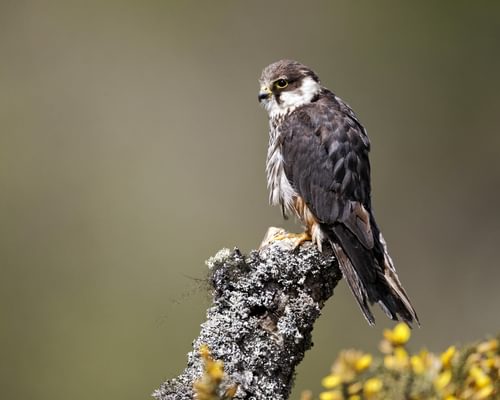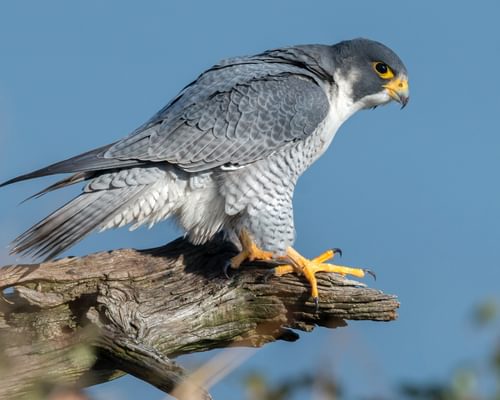Eleonora's Falcon
Least ConcernFalco eleonorae
Visual Identification
Appearance
Eleonora's Falcon is a sleek, medium-sized raptor with long, pointed wings and a long tail. Its plumage varies, with two colour morphs: dark and light.
The dark morph is uniformly dark brown, while the light morph has a grey-brown back and white underparts with dark barring.
Both morphs have a dark 'moustache' stripe and yellow eye-ring. Juveniles resemble light morphs but have buff-tinged underparts and a blue-grey cere.
Size
Length
36cm to 42cm
Wingspan
87cm to 104cm
Weight
350g to 450g
Colours
Males and females have similar plumage
Primary Colour
Brown Grey
Secondary Colour
White Black
Beak Colour
Black
Leg Colour
Yellow
Habitat and Distribution
Habitats
Woodland
Garden
Wetland
Coastal
Urban
Farmland
Grassland
Desert
Tundra
Rainforest
Mountain
Savanna
Distribution
Eleonora's Falcon breeds on small islands and coastal cliffs in the Mediterranean Sea, from Spain and Morocco to Greece and Cyprus. It also nests on islands off the northwest coast of Africa, including the Canary Islands.
During non-breeding seasons, these falcons migrate to Madagascar and nearby islands in the Indian Ocean, where they spend the winter months in coastal and inland habitats.
Elevation Range
Sea level to 1,000 meters
Climate zones
Mediterranean, Tropical
Distribution Map
This map gives you a rough idea of where you might spot a Eleonora's Falcon. The coloured areas show countries where these birds have been seen.
A few things to keep in mind:
- Birds might not be everywhere in the coloured areas, for example, they may be present around the coast of that country
- Where birds live can change with seasons and available food
- This map is quite simple - it doesn't show exact locations
We're working on making our maps even better! Soon, we hope to show you:
- More detailed maps for bigger countries, including state and region
- How birds move around during different seasons
Distribution by Region
Behaviour and Ecology
Bird Attributes
This feature is in beta. We'd love your feedback to improve it!
Share your thoughtsBird Attributes Explained
Our bird attributes system rates various aspects of a bird's capabilities on a scale of 0-100, based on data from field observations, scientific studies, and expert knowledge.
Attribute Categories:
- Agility: Manoeuvrability, speed, and grace in flight or movement.
- Strength: Physical power, often correlating with size and hunting abilities.
- Adaptability: Ability to thrive in various environments or changing conditions.
- Aggressiveness: Territorial behaviour and assertiveness, particularly during breeding seasons.
- Endurance: Stamina, often seen in migration patterns or foraging behaviours.
Understanding the Ratings:
- 0-20: Very Low
- 21-40: Low
- 41-60: Average
- 61-80: High
- 81-100: Very High
Remember, these attributes are relative to other bird species and don't necessarily indicate superiority.
Hover over the icon next to each attribute for more information.
Tap the icon next to each attribute for more information.
Agility
Reflects the bird's manoeuvrability, speed, and grace in flight or movement.
Eleonora's Falcon displays exceptional agility, with its sleek build and long, pointed wings enabling swift flight and rapid manoeuvres. Its ability to catch prey in mid-air, even in complete darkness, demonstrates remarkable aerial prowess.
Strength
Indicates the bird's physical power, often correlating with size and hunting abilities.
While not the strongest raptor, Eleonora's Falcon possesses considerable strength for its size. It can carry small migratory birds in flight and has the power to execute quick aerial attacks, though it's not built for carrying heavy prey.
Adaptability
Represents the bird's ability to thrive in various environments or changing conditions.
This falcon shows high adaptability, switching its diet between birds and insects based on seasonal availability. Its ability to breed on various coastal terrains and migrate long distances to wintering grounds in Madagascar further demonstrates its adaptiveness.
Aggressiveness
Measures the bird's territorial behaviour and assertiveness, particularly during breeding seasons.
Eleonora's Falcon exhibits moderate aggressiveness, particularly during breeding season. Its cooperative hunting behaviour and colonial nesting suggest a balance between aggression and sociability. However, it's certainly capable of fierce hunting tactics when necessary.
Endurance
Reflects the bird's stamina, often seen in migration patterns or foraging behaviours.
The long-distance migration from Mediterranean breeding grounds to Madagascar, coupled with its aerial hunting style, indicates high endurance. Its ability to sustain flight for extended periods, both during migration and while hunting, showcases impressive stamina.
Diet
Eleonora's Falcon has a highly specialised diet during the breeding season, primarily catching small migratory birds in mid-air.
Outside the breeding season, it feeds on large insects such as dragonflies and beetles. Its ability to switch between bird and insect prey allows it to adapt to seasonal food availability.
Behaviour
Eleonora's Falcon is known for its unique breeding strategy, which is timing reproduction to coincide with autumn bird migrations. It is highly aerial, spending much of its time soaring and hunting in flight. These falcons are social, often nesting in colonies and engaging in cooperative hunting behaviours.
Vocalisation
Eleonora's Falcon has a range of vocalisations primarily used during the breeding season. Its most common call is a sharp, high-pitched 'kee-kee-kee' or 'ki-ki-ki', often given in flight or when alarmed. During courtship, pairs may engage in duet calling with rapid, excited exchanges.
Nesting & Breeding
Breeding occurs from July to October, coinciding with autumn bird migrations. Eleonora's Falcons form monogamous pairs and often nest in colonies on rocky cliffs or slopes.
Nests are simple scrapes on ledges or in small caves, sometimes lined with vegetation. Females typically lay 2-3 eggs, which are reddish-brown with darker spots.
Incubation lasts about 28-30 days, shared by both parents. Chicks fledge after 35-40 days but remain dependent on parents for several more weeks.
Lifespan
years
The Eleonora's Falcon typically lives for 16 to 20 years.
Like all birds, lifespan can be affected by factors including predation, habitat quality, disease, and access to food sources.
Conservation and Status
Global Conservation Status
While currently listed as Least Concern, Eleonora's Falcon faces threats from habitat loss and degradation on its breeding islands. Climate change may affect its prey availability and breeding success. Conservation efforts focus on protecting breeding sites and monitoring population trends.
Birdwatching Tips
- Look for Eleonora's Falcons near coastal cliffs and small islands in the Mediterranean and off the northwest African coast.
- Observe their distinctive flight pattern: swift, rapid wing beats interspersed with glides.
- Visit breeding sites in late summer to early autumn to see their spectacular aerial hunting displays.
- Listen for their sharp, high-pitched calls during breeding season.
Additional Information
Quick Facts
Other names:
Eleonora's Hawk
Family:
FalconidaePredators
Adult Eleonora's Falcons have few natural predators, but eggs and chicks may be vulnerable to gulls, ravens, and introduced mammals on breeding islands.
Did You Know?
- The Eleonora’s falcon was named after Eleonora of Arborea (1347 – 1404), who in 1383 became the principal judge of one of four independent judicial regions of Sardinia, following in the footsteps of her late father and brother. A keen falconer, in 1392, she passed a law protecting birds’ nests against illegal hunters. This legislation is believed to have been the first of its kind anywhere in the world.
- These falcons can catch prey in complete darkness, relying on the moon's and stars' light.
- Some individuals can live up to 16 years in the wild, an impressive lifespan for a medium-sized raptor.
- For some time, it has been known that adult birds often store dead prey in ‘larders’, but following a study at a breeding site on an island off the coast of Morocco in 2014, scientists discovered that Eleonora’s falcons were catching small birds and keeping them alive to ensure a supply of fresh food. The unfortunate prey were plucked of their wing and tail feathers to prevent escape and kept in small cracks and holes in the rocks at nesting sites. This is the only bird currently known to carry out this practice.
Was this bird profile helpful?
Your feedback helps us improve our content
Thanks for your feedback!
Your input helps us improve our content.
Community Experience
Community Ratings
No ratings yet - be the first to rate this bird!
Latest Community Reviews
No reviews yet
Sign in to be the first to review
Community Reviews
Create Your Free Account Welcome Back!
Join our community to rate birds and share your experiences. Creating an account is completely free and only takes a minute. Sign in to your account to rate birds and share your experiences with our community.
Your information is secure and will never be shared.
By creating an account, you agree to our Privacy Policy.
Similar Birds
References
- 1 2 3
website: BirdLife International. 2021. Falco eleonorae. The IUCN Red List of Threatened Species 2021: e.T22696442A205714571.
View source

